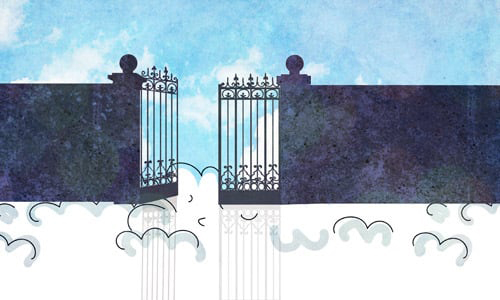|
Getting your Trinity Audio player ready...
|
By: Chabad.org
The ten days from Rosh Hashanah to Yom Kippur are known as Aseret Yemei Teshuvah, or the Ten Days of Repentance (more accurately translated as the Ten Days of Return).
When the prophet Isaiah tells the Jewish nation to repent for their sins, he says, “Seek G‑d when He may be found; call Him when He is close.”1 When is that? The sages say that this verse refers to these ten days, when G‑d is especially close to us.
The sages describe this period as a time when “the gates of heaven are open, and I will listen to your prayers.”
Maimonides2 explains:
“Even though repentance and crying out to G‑d are always timely, during the ten days from Rosh Hashanah to Yom Kippur it is exceedingly appropriate, and accepted immediately [on high].
“For these reasons,” continues Maimonides, “it is customary for all of Israel to give profusely to charity, perform many good deeds, and be occupied with observance of G‑d’s commandments from Rosh Hashanah until Yom Kippur to a greater extent than during the remainder of the year.3
Why is this period unique? Rabbi Shmuel Eliezer Edeles (Maharsha, 1555-1631) explains that our fate for the coming year is decided on Rosh Hashanah but not sealed until Yom Kippur. Accordingly, this is the time to return to G‑d and beg Him to change the judgment for the better.4
In Prayers
There are a number of tweaks made to the daily prayer service that you need to watch out for:
During morning services, after the Yishtabach blessing, it is customary to say Psalm 130.
Three times a day, in the Amidah (standing prayer), we substitute the phrases haE-l hakadosh (“the holy G‑d”) with hamelech hakadosh (“the holy king”), and melech ohev tzedakah umishpat (“king who loves righteousness and justice”) with hamelech hamishpat (“the king of judgement”). There are a number of other insertions that were instituted by the medieval sages which can be found in the prayerbook.
Following the Amidah, and the subsequent Tachanun (supplicatory prayers), we add the full Avinu Malkeinu prayer.
As we have been doing since the start of the month of Elul (and will do until the seventh day of Sukkot, Hoshana Rabbah), we say Psalm 27 following morning and afternoon (or evening) prayers.
The following two customs are not observed in Chabad:
In Kaddish, some have the custom to say, l’eila ul’eila (“above and beyond”), in reference to G‑d’s greatness, instead of the usual l’eila (“beyond”). (In Chabad, the extra words are reserved for the Neilah prayer on Yom Kippur).
The widespread custom is to recite special selichot (penitential prayers) before dawn. In Chabad, they are said only on the Fast of Gedaliah (more on that to follow).
General Practices
Ideally, during this time we decrease our involvement with worldly matters (almost like the quasi-holiday period of Chol Hamoed), and increase our Torah study and charitable giving.
In these days before Yom Kippur, some are careful to settle all debts so that they come to the holy day with a clean slate.
This is a time to be extra careful with all mitzvah observances. For example, one who is generally not careful regarding eating bread that is kosher but baked by non-Jews should eat bread baked only by Jews during this time.
Due to the solemn nature of this time of year, it is customary to refrain from scheduling weddings during these days (note that the day after Yom Kippur is considered an especially auspicious wedding date).
Special Days
The day following Rosh Hashanah is the Fast of Gedalia, when we mourn the death of Gedaliah, the leader of the Jewish people in the Holy Land following the destruction of the First Temple in 3338 (423 BCE).
The Shabbat between Rosh Hashanah and Yom Kippur is called Shabbat Shuvah, “Shabbat of Return.” The name derives from the Haftarah (reading from the prophets) for this Shabbat, which opens with the words, “Return O Israel unto the L‑rd your G‑d.”5 Along with Shabbat Hagadol (the Shabbat preceding Passover), this is one of the two times a year when it is customary for rabbis to deliver (longer than usual) speeches on timely topics. As on Rosh Hashanah, we dip our challah in honey at the start of the Shabbat meals.
The day before Yom Kippur is one of the busiest days of the Jewish year. In the wee hours of the morning, it is customary to perform the Kaparot ceremony with a live chicken or money, during which we say,“This is my replacement, this is my exchange, this is my atonement; this fowl shall go to its death, and I shall go to a long, good and peaceful life.” Already in a holiday mood, Tachanun is omitted from prayers, and we eat two festive meals, one at midday, and one just before the fast, which begins at sunset. Traditional foods include lekach (honey cake) and kreplach (stuffed dumplings). The Talmud states, “Whoever eats and drinks on the ninth [of Tishrei], it is regarded as if he had fasted on both the ninth and the tenth.”6
A Kabbalistic Insight
The master Kabbalist Rabbi Isaac Luria (the Arizal) taught that the seven days between Rosh Hashanah and Yom Kippur (which always include one Sunday, one Monday, etc.) correspond to the seven days of the week, each day representing all the corresponding days of the year: the Sunday embodies all Sundays; the Monday embodies all Mondays, and so on. Let’s make sure to use these days wisely.
Footnotes
- Isaiah 55:6
- Mishneh Torah, Laws of Teshuvah 2:6.
- Mishneh Torah, Laws of Teshuvah 3:4.
- Maharsha to Yevamot 49b.
- Hosea 14:2.
- Talmud, Berachot 8b.





